Becca Hillburn's Blog, page 3
May 25, 2020
Watercolor Illustrator Starter Kit

Let's say you've been watching watercolor tutorials for years now, and you're ready to take the plunge! You want to skip a lot of the student-grade stuff and invest your money in art supplies you're going to enjoy now- and for years to come.
Or maybe you're a professional artist- just new to watercolor. You already have a trained eye, skilled hands, and know that good art supplies are worth the investment- you just aren't sure where to start!
The labeling on most art supplies promise all sorts of things
artist quality professional quality high quality pigmentsbut since those promises aren't regulated, there's no guarantee that they're the truth. Over the years, I've reviewed a lot of art supplies that promised a lot and delivered frustration, so hopefully my recommendations today will help you buy with confidence!
All Amazon links are affiliate links- I see a small bounty when you shop using those links! This is a great way to help support the work I do here, at no extra cost to you.My Reccs:Paints: Daniel Smith Essential 6 Mixing Set- $49.99 on AmazonQor Mini Palette- $69.78 on AmazonWatercolor Pencils:
Derwent Inktense Watercolor Pencils- price varies by set on Amazon
Brushes:
Cotman Mop- $16.00 on Amazon
Princeton Aqua Elite- prices vary by set on AmazonCreative Mark Mimic- Size 10 or larger- $19.79 on Jerry's ArtaramaSilver Black Velvet Brushes- Price varies by size on DickBlickWinsor and Newton Series 7 Brush- Size 5- $34.00 on DickBlickLarge Hake Brush- prices vary on size on DickBlickPapers- Cellulose:Canson Montval- prices vary by size on AmazonCanson XL- prices vary by size on AmazonPapers- Cottonrag: Stonehenge Aqua Coldpress- prices vary by size on AmazonFluid 100- prices vary by size on AmazonBlick Studio Premier- prices vary by size on DickBlickPadbound Arches Coldpress- prices vary on Amazon
Wanna get all your shopping done in one place? Here's a link to the Amazon list!
My most commonly used brush type: roundMy most commonly used brush material: squirrel synthetic mixMy most commonly used brush size- 6 or 8 roundMy most commonly used paper sizes- 9"x12", 10"x14"My most commonly used paper type for illustration- cottonragMy most commonly used paper type for comic pages- celluloseMy most commonly used paper surface- coldpress textureMy most commonly used paper weight- 140lb
What about accessories?! I've written about them here! But here's a few relevant links and blurbs from that post!
Winsor and Newton Masking Fluid
This is the brand I use and have had best results with.
Pebeo Masking Fluid
This is the brand Kabocha uses and has had the best results with.
Masking Fluid Accessories:
Synthetic watercolor brushes
Brush Soap
Masking Fluid Pick Up
Sakura Pigma FB, MB, BB
These three brushpens provide a variety of lineweights and are alcohol marker and waterproof. I use these in many of my videos!
Cups
You can really use any, but I particularly like these collapsable cups by Faber Castell. I recommend two dedicated watercolor cups- one for clean, one for dirty.
Spray Bottle
Eye Droppers
Paper Towels
Any paper towels will work, but I really love Viva paper towels, especially the ones with no texture.
Gator Board or Corrogated Plastic
I use this to serve as a support for my stretched watercolor pages.
Tutorial:
Masking Tape
I prefer the 3M blue crepe masking tape linked above- it adheres to the page without tearing the paper on removal.
Bulldog Clips
Binder Clips
I use binder and bulldog clips to help secure my paper to the board when stretching watercolor paper.
Paint Keys

Top three: Canson Montval Watercolor Paper
Middle Three: Montval, Stonehenge Aqua Hotpress, Stonehenge Aqua Coldpress
Bottom Three: Canson Montval Artboard, Cheap Joe's Kilimanjaro, Strathmore Toned Tan Mixed Media PaperWhat's to love about:
Daniel Smith Essential 6 Mixing Set
A lot of professional artists talk about mixing every color you need from a good set of limited colors. This is absolutely possible, and my pick for that is the Daniel Smith Essential 6. Daniel Smith is a professional line of watercolor made and manufactured in the US using high quality pigments. Their staff are friendly and willing to answer questions, and provide a lot of outreach. Starting with a limited palette of six colors helps you learn the intricacies of color mixing while saving A LOT of money- just add to your palette as you go.
I recommend also buying some inexpensive empty half pans and creating your own mini palette using a mint tin. Personally, I find working from half pans to be easier than working directly from tubes, and generates less waste.
Check out the fieldtest for these- they demonstrate just how mixable they are!
Qor Mini Palette
Maybe six colors just isn't enough. The Qor Mini Palette of 12 brilliant colors is one of my favorite go to palettes for travel or limited space. Although the halfpans are smaller than normal, a little goes a LONG way, and these colors are super saturated and fun to mix! This is a palette I grab all the time- it plays particularly well with cellulose watercolor papers.
Check out the unbox and swatch for my first impressions, and the fieldtest to see how well they handle! If you go through my Watercolor Basics playlist, you'll see this palette pop up often- it really is a favorite!
Derwent Inktense Watercolor Pencils
Watercolor pencils can be great for travel, or for adding finer details to watercolor illustration. I use them all the time for 7" Kara comic pages. I've used and reviewed a lot of different watercolor pencil brands over the years, and Derwent's Inktense line is one of my favorite, and a fairly economical option. These India Ink pencils are not true watercolor pencils, and will be fairly lightfast and indelible once dry, so save them for your final details!
These pop up in a number of my 7" Kara process posts, frequently in my Watercolor Basics series, and in several Youtube videos! A standalone review has been recorded, and is in the hopper, so keep an eye on my channel!
Cotman Mops
Mops are ideal for covering large areas of your paper with color or water! Cotman watercolor mops are available in two sizes and use synthetic fibers, so they're a very economical option for your studio that will last a LONG time. I use the same mop I purchased ten years ago, when I first started painting 7" Kara! This is great for toning larger panels and pages, and useful for stretching smaller watercolor pieces.
Since this is so frequently used, it's appeared in several Watercolor Basics posts, in a number of Holiday gift guides, and has made many an appearance on my channel!
Large Hake Brush
One of my favorites for stretching watercolor paper- I can apply water faster and more evenly than using a mop! These are really inexpensive, and great to have around.
Since this is a newer improvement in my life, it hasn't yet started to filter into blog posts and on Youtube, but keep an eye out, now that I've tried it, I'm convinced others should too!
Princeton Aqua Elite
A stiffer synthetic brush that's useful for applying gouache, thick applications of watercolor, or pulling really precise lines.
Creative Mark Mimic- Size 10 or Larger
Natural hair brushes, particularly squirrel and sable, are expensive at larger sizes. I recommend buying synthetic brushes for these larger sizes- they're economical and will last a long time. I use synthetics for anything size 8 or larger, with my largest brush being a Creative Mark Mimic in size 26. These are really handy for blocking in color or applying light glazes, and the Mimic is far less stiff than many other inexpensive synthetic brushes.
Since this is so frequently used, it's appeared in several Watercolor Basics posts, in a number of Holiday gift guides, and has made many an appearance on my channel!
Silver Black Velvet Brushes
A mix of synthetic and natural hair brushes, Silver Black Velvet handle ALMOST like Kolinsky Sable, but cost far less. These are great studio workhorses, and the mix of synthetic add durability, while the natural squirrel hair holds onto water and paint to reduce dribbling.
These appear in several newer watercolor videos, as well as in my 2018 gift guide!
Winsor and Newton Series 7
Brush work is important- it adds a lot of vitality to a piece. Having a brush that work WITH you, not just pushing paint around or puddling everywhere, makes painting a delight and will improve your work.
The Series 7 is one of the best commonly available Kolinsky Sable brushes available in the US, and while quite expensive, it's an investment that will make painting a joy. After years of using synthetic and squirrel brushes, the Series 7 seems to dance on the paper, and a well maintained round is capable of very thin lines as well as bold brushwork. The flagged hairs of Kolinsky Sable hold on to paint and water, so drip drip dribbles are far less common, and the brush itself is easier to control.
Since this is so frequently used, it's appeared in several Watercolor Basics posts, in a number of Holiday gift guides, and has made many an appearance on my channel!
Canson Montval
While this isn't everyone's favorite (I've gotten a little flack for recommending it from folks who've been burnt), it's still my paper of choice for 7" Kara pages. I find it handles ALMOST like a cottonrag, but is capable of much finer detail- a must for painting comic pages.
Since this is a personal favorite, it's appeared in several blog posts discussing papers for watercolor, and of course it appears in every 7" Kara process post- so you see it used frequently! It's also in quite a few watercolor comic videos on the channel.
Obviously, since I've used it for hundreds of comic pages, I've talked about it a fair amount just about everywhere, from Twitter to Youtube to this blog. And of course, you can check out my handiwork by reading 7" Kara!
Canson XL
Sometimes it's nice just to have cheap paper handy- after all, sometimes you just want to sketch in watercolor! I use Canson XL for watercolor sketches (I really like how commonly available their little watercolor sketchbooks are, I can get them just about anywhere with a small art supply section, even rural Luling's Walmart) and creating paperchildren. Thicker than Moleskin and Handbook watercolor books, Canson XL may be a great choice for your watercolor doodles.
I use Canson XL pretty frequently so if you follow my Instagram, you've probably seen pieces painted on XL. Here's an example!
Padbound Arches Coldpress
For standalone watercolor illustrations and paintings, I love using cottonrag watercolor paper. Finding the right paper for your needs is important- there is no panacea paper designed to suit every artist. I really like Arche's padbound Coldpress sheets- already cut to workable sizes, fairly affordable, and will run through my printer like a dream. I buy the 140lb weight and always stretch my cottonrag paper.
Since this is so frequently used, it's appeared in several Watercolor Basics posts, in a number of Holiday gift guides, and has made many an appearance on my channel!
Stonehenge Aqua Coldpress
Blockbound on two sides, you may find this paper a bit prone to buckling or removing itself from the pad, especially at larger sizes. I remove it from the block to run through my printer, so I end up stretching this paper regardless. Their coldpress is even available in black!
If you're more of a fan of the smooth texture of hotpress, their Hotpress cottonrag watercolor blocks are excellent, and less prone to self-removal, as working on hotpress dictates fewer super wet washes.
Check out this comparative review between Stonehenge Aqua Coldpress and Hotpress!
Fluid 100
A coldpress cottonrag paper that has ALMOST the texture of hotpress (although it's available in hotpress too!). This is a very mild blockbound paper available in a wide range of sizes. It's very economical for a blockbound cottonrag paper, and has a very easy to work with temperament- so it's a great cottonrag for beginners!
Check out the fieldtest here for more information! And here's a standalone review.
Blick Studio Premier
I use this as a more economical alternative to blockbound Arches. A favorite during my Unbox and Swatch videos- this paper has a lot of tooth, and an excellent block binding that's not going to self remove. This is produced for sale exclusively at Dick Blick, so availability is limited, but you can order it online if you're willing to wait a week for it to arrive at your door!
This paper pops up in most unbox and swatch watercolor reviews, but I also have a timelapse painting on Blick Premier.
Learn more about the paints you're buying:Pick a Palette- Selecting the Paints You NeedPigments and Paints
Learn more about the papers I'm recommending:All About that Paper
Learn more about the brushes I'm recommending:The Great Brush OffWatercolor Brush OverviewWaterbrushes Vs Traditional Watercolor Brushes
I've talked about watercolor recommendations for younger artists and for beginners in some of my Holiday Gift Guides, so if you're looking for something a little less expensive, I recommend checking those out! And I'm always happy to provide curated recommendations- via Twitter, Patreon, or in my art-centric Discord server, The Paintbox!
Watercolor Gift Guide for Young Artists Ages 9-13Watercolor Artist Gift Guide: Beginner2018 Holiday Gift GuideTop 10 Products of 2018

Published on May 25, 2020 14:17
May 21, 2020
The Journey to Kickstarter- 7" Kara Volume 2
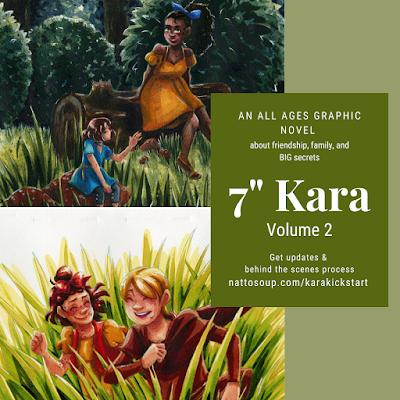
Intrepid blog readers may have noticed that my updates have decreased significantly. I haven't stopped writing- I'm just putting all that brainpower towards creating great content for the 7" Kara Volume 2 mailing list!
It's been a long road finishing up Volume 2, and I still have a little ways left to walk, but I want to share the journey with you guys. My goal for the mailing list is to not only get you excited about Volume 2, but to share some behind the scenes process and comic knowledge. I have some early access tutorials queued up detailing the planning, drawing, inking, and watercolor process for the bonus Naomi chapter, and I'm excited to share my adventures in advertising and newly gained print knowledge. I plan on keeping some of that exclusive to the mailing list, so if you're curious about making your own comics, sign up!
The 7" Kara Volume 2 mailing list has already launched, so if you want comic process and news delivered to your inbox, you can sign up now! It's sorta like those halcyon days of feedreaders- you don't have to check your favorites or remember my URL!
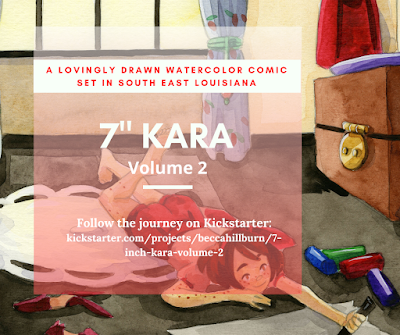
If you want to support Volume 2, but you're not interested in process, you can join us on the Kickstarter prelaunch page and tell Kickstarter you want to be notified when we launch.
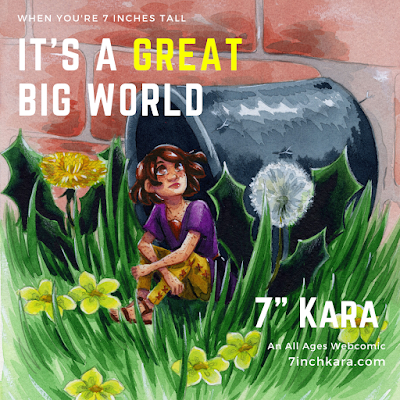
If you haven't had a chance to read 7" Kara, the first six chapters are available as a webcomic! You can read it at7inchkara.com7inchkara.tumblr.com
7" Kara may be on a webcomic hiatus, but I've been busily working on new chapters! Volume 2 includes three never before shared chapters, a guest art gallery, and LOADS of new content! And I have big plans for Kickstarter tiers and stretch goals, including home and classroom activities for parents, teachers, and librarians! I can't wait to tell you all about it via email!

I'm excited to share all the good things I've been working on!

Published on May 21, 2020 14:00
May 18, 2020
Teaching Online Vs Teaching in Person
Teaching online and teaching in person are two very different experiences, but don't let the fact that there's a learning curve in both directions deter you from trying! Teaching, both online and off, can be improved with practice, feedback, and research.
This isn't intended to be an in-depth post- teaching art, particularly as a freelance worker- can be complicated and nuanced, and would merit it's own series. Even then, I wouldn't necessarily feel comfortable sharing such a series as a How To, as I definitely still have much to learn.
I have a fair amount of experience teaching online and in person, and am always open to learning new techniques to improve my work and the viewer's experience.
** denotes personal experience teaching this kind of class
Teaching Online:
 Screenshot from a recent Livestream workshop hosted on Youtube
Screenshot from a recent Livestream workshop hosted on YoutubeOptions:
Written- blog post**
Written- zine
Youtube- standalone**
Youtube- livestreams**
Twitch Streams
Youtube Live
Instagram Live
Zoom class**
Zoom webinar
Recorded workshop**
Podcasts**
Google Hangouts On Air
Skillshare
Bluprint
Discord
Pros:
Can do it from the comfort of your own homeDon't need someone else's approval to startOnline classes can really expand your reach and audience- you're not just tied to local studentsEasier to share digital resourcesEasier to record online events and share them than it is to record an inperson event and record it later
Cons:
Need equipment that can handle recording, streaming, editing, photographyTechnical issues can destroy the entire workshop, rather than just acting as an obstacleInternet connectivity can make or break you, so people in rural areas (like South East Louisiana) may find themselves at a disadvantage (speaking from experience here)May not see consistent payment- or any payment at allMonetizing free resources is challengingResponsible for your own promotionTied to the whims of the audience in terms of promotion and support- you REALLY need that positive word of mouth to growCan be depression to never see the work your students make, or not have real time interactions with your studentsStudents may not have access to the materialsDifficult to keep people engagedDifficult to gauge how effective the material isSometimes difficult to address and correct problemsOnline content is often taken for granted, and people don't value online content as much as they do physical, in person events
Teaching in Person:
 Photo from one of my comic classes taught with St Charles Parish Library
Photo from one of my comic classes taught with St Charles Parish LibraryOptions:
9-5 regular teaching position
Convention panels**
Convention Workshops**
Library workshops**
Classes through an art supply store**
Subcontracting under another art school**
Private tutoring
Meetup
Pros:
PAYMENT! - Generally when you teach physical classes, payment is an expected part of the transaction. If payment isn't mentioned by your employer, make sure you mention what your rate isWorking with students in person, in real time, allows you to get to know them as people, provides an opportunity for socialization, and allows you to give them real time feedback If you provide the materials, you can guarantee students have access to what you want them to use
Cons:
Often responsible for providing all or most of the materialsWhen working as a contract employee, responsible for the above, as well as creating lesson plans, activities- this takes up a lot of time that you may not see compensation forOften need someone willing to give you that first chanceTransportation! Students often need to leave home to attend in person classes so a lack of public transportation, traffic issues, and lack of parking can severely hurt attendance Often need assistance
Notes on Teaching: Promotion:
For in person events, it's often easier to promote that event in person or using physical materials
FliersMentioning events at other eventsRequesting students talk about it with friends
For online events, it's easier to promote that event online
Utilize your social media accounts to talk about your classesUse hashtags to reach interested students outside your networkAsk friends to share your posts
I've talked about promoting your in-person classes on a budget in my Promoting a Class or Workshop post.
Teaching online can be a great way to get some practice in teaching, and learning HOW to teach. Just because you're a skilled artist doesn't mean you're cut out for teaching- social skills, a genuine love for other people, and the ability to think critically and dissect process are all important both online and off.
If you're new to teaching in person, I would recommend NOT volunteering to teach classes free. This was a method I took when I was first starting out, and to my dismay, I was informed by several sources that they would only consider PAID classes as work experience. This was a frustrating misstep, as I'd offered my services free so I could build up a work history.
You may find it challenging to find someone willing to give you that first paid opportunity. Even with dozens of workshops under my belt (taught through conventions), two teaching internships, AND an MFA, I struggled to find an employer willing to work with me here in Nashville.
For example, I'd lived in Nashville FIVE YEARS, and consistently pitched classes and workshops, before finally convincing NCE to give me a shot. This first class- Making Comics and Zines, opened the door to other teaching venues such as Plaza and The Little Arthouse. However, it took five years of consistent pitching, and constantly mentioning that I teach comic classes to convince someone to give me that first chance here in Nashville. The takeaway here is PERSISTENCE.
Teaching online isn't a good fit for everyone. Personality is a huge part of online popularity, promotion, and even extends to classes and tutorials. You may have to work hard to find your niche online, and may find that it's not necessarily worth the time and distraction away from other projects. You have a LOT options when it comes to streaming, each with their own unique ecosystem, so it pays to do your research and watch a few examples to get a feel for what's right for you.
Online retention is a challenge, as users are spoiled for choice and entertainment. Music can help keep students engaged during online workshops and classes. I recommend doing your research and using Royalty Free and Creative Commons music during livestreams and as background music during tutorials. Actively engaging the chat, utilizing a facecam during streams, and using a mic are all great ways to stay connected during streamed events.
Programs like Zoom have their unique pros and cons. Zoom allows you to host a large audience AND interact with them. With a little savvy, you can control when students can interrupt the conversation, and students with webcams are able to show you their work. Unfortunately, Zoom streams have been hijacked a few times with illegal content, so you may want to be careful with how you promote Zoom streams.
More on Teaching Comics and Art:
Tips for Teaching Comics
Teaching Comics Professionally
Teaching a Comic Craft Module in Your Classroom
Materials for Teaching Comics Classes
In Defense of the Mini Comic
Promoting a Class or Workshop

Published on May 18, 2020 13:01
May 14, 2020
May 2020 Covid19 Update
Hey guys! It's been awhile since I've updated the blog, hasn't it? I thought a catch up post was in order! As always, if you're interested in what I have to say, Twitter is a great place to keep up with daily goings on and to chat! And if you enjoy my art, I share it regularly on Instagram.
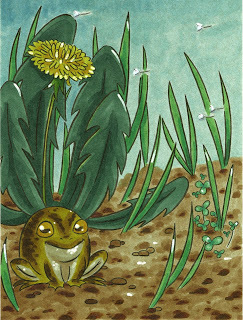
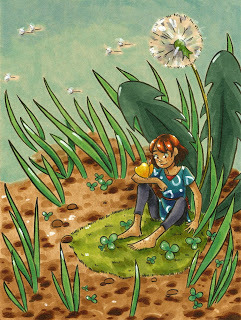
COVID19 has most of my readers in some form of lockdown, and that includes me. That means no just for fun trips to Jerry's Artarama and no in-person classes at PlaZa, so as you can imagine, that also means I'm buying far fewer new art supplies. While I miss going to art supply stores (they're so relaxing for me!), it's nice to focus a bit more on my backlog of reviews. And it's not just PlaZa that's had to cancel classes- my classes with The Little Arthouse, Nashville Public Library, and Watkins Art College were all cancelled as well, leaving my March financially bereft. Fortunately, as of today, my family and I are all mostly in good health, and I hope this can continue.
So what's been going on?
In March, right before the stay home orders went out, I flew down to help my mother for surgery. Unfortunately, her surgery was cancelled, and I ended up staying in Louisiana an extra week, hunkering down in self quarantine. Joseph drove down to come get me, and we drove the eight hour drive back up to Nashville (and more self quarantine). While there, I painted a BUNCH of etegami postcards and reviewed a bunch of mechanical pencils. Artnerds have already received all the videos as early access, and the etegami tutorials drop on Mondays on my Youtube.
To help others (and myself) deal with all this self isolation, I started streaming again, switching our night from Friday to Saturday. Every week, I try to present a self contained art workshop- the goal is to create a piece of art from start to finish, live on stream. We've done watercolor marker waterlilies, metallic fish on black watercolor paper, alcohol marker tree frogs, and three color roses, and this week, we're going to do poison dart tree frogs in POSCA on black paper! The stream starts at 8PM CST on Saturday nights, so I hope I'll see you there!
Even before the stay home orders, I've been painting SO MUCH. I've mentioned it on just about every social platform, but I'm just about finished with 7" Kara Volume 2, so I've been working on painting bonus illustrations to finish out and promote the book once we're ready to launch. I definitely want to talk about my journey to Kickstarter more in another post, since we've been trying a few different things. Some of these paintings have been recorded as tutorials, but many were not. You can check out almost everything I've been working on recently on Instagram!
Joseph's been working like a mad scientist to get an advertising campaign going for Volume 2. His first priority has been starting and populating a Volume 2 mailing list. This one's a little different from the Artnerd mailing list- the Artnerd mailing list focuses more generally on art and art supplies, but the Volume 2 mailing list is all about creating 7" Kara Volume 2! My writing time and brainspace has gone from updating the blog to creating posts for the mailing list, so if you're interested in how I make comics, or would like information on Volume 2, please sign up!
As a thank you, you have your choice of a free PDF of Volume 1, or a free PDF of Lilliputian Living Volume 1!
Right at the end of April, my mom's surgery was rescheduled, so Joseph and I drove the 8 hours down and 8 hours back up to help out after that. Unfortunately, it seems like her surgeon didn't get all of it, so while she's scheduled to go in AGAIN on the 22nd, I cannot afford to make the drive twice in the same month, so sadly, I'll be staying here.
Although in-person classes have been cancelled, and I've lost a significant stream of income, a few of my favorite employers are moving towards online class options, and haven't forgotten me! Hopefully I'll be able to regularly host Zoom classes in the near future! If you're a parent, teacher, librarian, or someone interested in private art lessons, and you'd like to arrange for Zoom classes for yourself or a small group of people (either in person or remotely), please contact me via email! I'm happy to help you design a curricula suited to your needs.
Growing in in Louisiana, I'm no stranger to hurricanes, cancelled school, life put on hold, and even sleeping on the floor of extended family. In some ways, this isn't so different from self isolating due to Covid- hurricanes have a way of shutting everything down and massively changing the trajectory of your life. Unfortunately for those of us who have suffered hurricanes, only the areas affected by that hurricane really appreciate the damage done, and even within those areas, accommodations may not be made to help those affected catch up. At least with Covid, we're all in this together and can empathize.
While my life has changed in some ways (I sorely miss teaching live classes, and I miss hitting up my favorite art supply stores), in others it's no different from the Nashville status quo. I've always been highly reliant on the internet for communication, sharing my work, and finding new work, and have used Youtube and this blog as teaching tools for a long time. I definitely miss social opportunities, and I know that the loss of those takes an emotional and mental toll, but it's important to stay home and try to create work that will entertain and uplift others.
It's almost like every family, every house, is it's own little raft floating on the ocean. Amazon deliveries are delivered via albatross, messages are shouted from raft to raft, or floated via bottles. Now that the Volume 2 mailing list has launched, I have a bit of brainspace open for updating the blog, and I'd love to talk to yall a bit more about my recent teaching experiences, how quarantine has affected the life of this work from home artist, and share my future adventures.
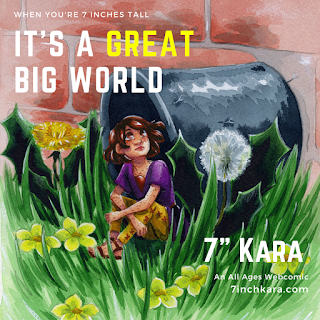
Have some free time? Need to entertain your kids?
Why not read 7" Kara together? You can download the PDF using the link above, or you can read the first six chapters at 7inchkara.com
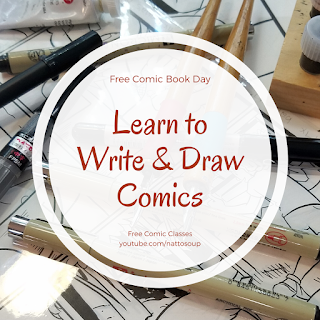
Want to start a new hobby? I have lots of great art classes on Youtube! Now is a great time to
Learn to draw:
Favorite Drawing Tutorials
Start Making Comics:
Intro to Comic Craft
Making Comics and Zines
Learn watercolor:
Quick and Easy Watercolor
Watercolor Basics


COVID19 has most of my readers in some form of lockdown, and that includes me. That means no just for fun trips to Jerry's Artarama and no in-person classes at PlaZa, so as you can imagine, that also means I'm buying far fewer new art supplies. While I miss going to art supply stores (they're so relaxing for me!), it's nice to focus a bit more on my backlog of reviews. And it's not just PlaZa that's had to cancel classes- my classes with The Little Arthouse, Nashville Public Library, and Watkins Art College were all cancelled as well, leaving my March financially bereft. Fortunately, as of today, my family and I are all mostly in good health, and I hope this can continue.
So what's been going on?
In March, right before the stay home orders went out, I flew down to help my mother for surgery. Unfortunately, her surgery was cancelled, and I ended up staying in Louisiana an extra week, hunkering down in self quarantine. Joseph drove down to come get me, and we drove the eight hour drive back up to Nashville (and more self quarantine). While there, I painted a BUNCH of etegami postcards and reviewed a bunch of mechanical pencils. Artnerds have already received all the videos as early access, and the etegami tutorials drop on Mondays on my Youtube.
To help others (and myself) deal with all this self isolation, I started streaming again, switching our night from Friday to Saturday. Every week, I try to present a self contained art workshop- the goal is to create a piece of art from start to finish, live on stream. We've done watercolor marker waterlilies, metallic fish on black watercolor paper, alcohol marker tree frogs, and three color roses, and this week, we're going to do poison dart tree frogs in POSCA on black paper! The stream starts at 8PM CST on Saturday nights, so I hope I'll see you there!
Even before the stay home orders, I've been painting SO MUCH. I've mentioned it on just about every social platform, but I'm just about finished with 7" Kara Volume 2, so I've been working on painting bonus illustrations to finish out and promote the book once we're ready to launch. I definitely want to talk about my journey to Kickstarter more in another post, since we've been trying a few different things. Some of these paintings have been recorded as tutorials, but many were not. You can check out almost everything I've been working on recently on Instagram!
Joseph's been working like a mad scientist to get an advertising campaign going for Volume 2. His first priority has been starting and populating a Volume 2 mailing list. This one's a little different from the Artnerd mailing list- the Artnerd mailing list focuses more generally on art and art supplies, but the Volume 2 mailing list is all about creating 7" Kara Volume 2! My writing time and brainspace has gone from updating the blog to creating posts for the mailing list, so if you're interested in how I make comics, or would like information on Volume 2, please sign up!
As a thank you, you have your choice of a free PDF of Volume 1, or a free PDF of Lilliputian Living Volume 1!
Right at the end of April, my mom's surgery was rescheduled, so Joseph and I drove the 8 hours down and 8 hours back up to help out after that. Unfortunately, it seems like her surgeon didn't get all of it, so while she's scheduled to go in AGAIN on the 22nd, I cannot afford to make the drive twice in the same month, so sadly, I'll be staying here.
Although in-person classes have been cancelled, and I've lost a significant stream of income, a few of my favorite employers are moving towards online class options, and haven't forgotten me! Hopefully I'll be able to regularly host Zoom classes in the near future! If you're a parent, teacher, librarian, or someone interested in private art lessons, and you'd like to arrange for Zoom classes for yourself or a small group of people (either in person or remotely), please contact me via email! I'm happy to help you design a curricula suited to your needs.
Growing in in Louisiana, I'm no stranger to hurricanes, cancelled school, life put on hold, and even sleeping on the floor of extended family. In some ways, this isn't so different from self isolating due to Covid- hurricanes have a way of shutting everything down and massively changing the trajectory of your life. Unfortunately for those of us who have suffered hurricanes, only the areas affected by that hurricane really appreciate the damage done, and even within those areas, accommodations may not be made to help those affected catch up. At least with Covid, we're all in this together and can empathize.
While my life has changed in some ways (I sorely miss teaching live classes, and I miss hitting up my favorite art supply stores), in others it's no different from the Nashville status quo. I've always been highly reliant on the internet for communication, sharing my work, and finding new work, and have used Youtube and this blog as teaching tools for a long time. I definitely miss social opportunities, and I know that the loss of those takes an emotional and mental toll, but it's important to stay home and try to create work that will entertain and uplift others.
It's almost like every family, every house, is it's own little raft floating on the ocean. Amazon deliveries are delivered via albatross, messages are shouted from raft to raft, or floated via bottles. Now that the Volume 2 mailing list has launched, I have a bit of brainspace open for updating the blog, and I'd love to talk to yall a bit more about my recent teaching experiences, how quarantine has affected the life of this work from home artist, and share my future adventures.

Have some free time? Need to entertain your kids?
Why not read 7" Kara together? You can download the PDF using the link above, or you can read the first six chapters at 7inchkara.com

Want to start a new hobby? I have lots of great art classes on Youtube! Now is a great time to
Learn to draw:
Favorite Drawing Tutorials
Start Making Comics:
Intro to Comic Craft
Making Comics and Zines
Learn watercolor:
Quick and Easy Watercolor
Watercolor Basics

Published on May 14, 2020 13:00
April 13, 2020
Everything You Need to Know About Watercolor Markers
On Saturday night, I hosted a live watercolor marker workshop over on Youtube. We talk about different types of waterbased markers, some techniques to use them, and together we use watercolor markers to paint a vibrant waterlily.
If you couldn't make it Saturday, you can check out the livestream here:
Watercolor markers come in two main ink types- pigment based inks (Winsor and Newton watercolor markers, Faber-Castell Albrecht Durer watercolor markers) and dye based inks, with dye based inks being the majority. I talk about watercolor markers a bit more in this blog post!: https://nattosoup.blogspot.com/2018/0...
Dye based watercolor markers don't really differ from regular waterbased markers like Crayola Supertips- what differs most is the tip and the way the markers are marketed, so if you have Supertips around, you can use these as watercolor markers!
In fact, here's a couple tutorials that show how to use Crayola Supertips as watercolor markers!
Crayola Supertips Watercolor Hack:
Love Beam: Crayola Supertip Tutorial
Undersea Mermaid
There are a few stand out great dye based watercolor markers though- Ecoline's (love the brush tip, and they're refillable!), and brushpen style watercolor markers like Mermaid Markers and Pentel's dye based brushpens. Keep reading for embedded videos of those reviews!
Here's a video to help you understand the differences between pigment and dye based watercolor markers. This should help you figure out which markers might be best for you!
The Best Watercolor Marker ?!- A Watercolor Marker Demonstration:
The difference between dye and pigment is important- it's going to drastically change how you handle these markers, and change what techniques you use.
In general, dye based watercolor marker art is going to have no granulation, it may have color separation as the dyes separate out into water, and how you actually handle the markers will differ, as dye based inks are often prone to reactivation AND staining.
In the end, your dye based watercolor marker art will also have a color gamut similar to alcohol markers, although they handle quite differently.
Pigment markers (including those that utilize India Ink) tend to be more permanent when dry, so you may not be able to blend or lift color. With direct application, they may stain the paper, and may be more difficult to blend using direct techniques.
So something you're going to want to consider when working with watercolor markers, regardless of ink type, is the fact that your tips will probably abrade the paper. Unlike alcohol marker ink, which dries almost immediately, waterbased and watercolor markers take longer to dry, leaving the paper vulnerable.
Watercolor markers, when applied to the paper, don't blend out as nicely as tube and pan watercolors, and you may not be able to blend out at all. This is why you may also want to work with a ceramic plate or non porous work surface and watercolor brushes or a waterbrush. This is also helpful for color mixing, and creating diluted version of your colors.
So now that we've talked about the basics, I'm going to share a few reviews for watercolor markers I like, in case you're in the market for markers!
Ecoline Watercolor Markers- Foam rubber brush tip, dye based, refillable
Blog Post: https://nattosoup.blogspot.com/2017/0...
Mermaid Markers- Brush tipped, dye based
Blog Post Review: https://nattosoup.blogspot.com/2018/0...
Pentel Brushpens- Brush tipped, dye based
Kuretake Clean Color Real Brush Markers
Blog Post: https://nattosoup.blogspot.com/2015/1...
Winsor and Newton Watercolor Markers (these are going to be discontinued soon):
Blog Post: https://nattosoup.blogspot.com/2014/1...
Albrecht Durer Watercolor Markers:
Karin Brushmarker Pro- Reviewing Polish Markers
And now some tutorials to help inspire your art!
Watercolor Marker Workshop (Winsor and Newton)
Winsor and Newton Watercolor Marker Tutorial
In the Name of the Moon! A Great Alternative to Alcohol Markers:
Painting Vibrant Succulents with Arrtx Watercolor Markers:
Mermaid Markers Field Test:
Paint a Pumpkin- Albrecht Durer Watercolor Markers on Strathmore Toned Blue:
Succulent with Zig Clean Color Real Brush Markers:
Pentel Brushpen Watercolor Field Test:
Succulents Step by Step with Ecoline:
Colored Leads and Clean Color Markers Tutorial:
Axolotl Illustration Tutorial with Zig Clean Color Real Brush:
In the Spirit of Friendship:
A Field of Flowers- Loose Watercolor Tutorial:
Here's a whole playlist of waterbased marker reviews and tutorials, if you want more!
If you couldn't make it Saturday, you can check out the livestream here:
Watercolor markers come in two main ink types- pigment based inks (Winsor and Newton watercolor markers, Faber-Castell Albrecht Durer watercolor markers) and dye based inks, with dye based inks being the majority. I talk about watercolor markers a bit more in this blog post!: https://nattosoup.blogspot.com/2018/0...
Dye based watercolor markers don't really differ from regular waterbased markers like Crayola Supertips- what differs most is the tip and the way the markers are marketed, so if you have Supertips around, you can use these as watercolor markers!
In fact, here's a couple tutorials that show how to use Crayola Supertips as watercolor markers!
Crayola Supertips Watercolor Hack:
Love Beam: Crayola Supertip Tutorial
Undersea Mermaid
There are a few stand out great dye based watercolor markers though- Ecoline's (love the brush tip, and they're refillable!), and brushpen style watercolor markers like Mermaid Markers and Pentel's dye based brushpens. Keep reading for embedded videos of those reviews!
Here's a video to help you understand the differences between pigment and dye based watercolor markers. This should help you figure out which markers might be best for you!
The Best Watercolor Marker ?!- A Watercolor Marker Demonstration:
The difference between dye and pigment is important- it's going to drastically change how you handle these markers, and change what techniques you use.
In general, dye based watercolor marker art is going to have no granulation, it may have color separation as the dyes separate out into water, and how you actually handle the markers will differ, as dye based inks are often prone to reactivation AND staining.
In the end, your dye based watercolor marker art will also have a color gamut similar to alcohol markers, although they handle quite differently.
Pigment markers (including those that utilize India Ink) tend to be more permanent when dry, so you may not be able to blend or lift color. With direct application, they may stain the paper, and may be more difficult to blend using direct techniques.
So something you're going to want to consider when working with watercolor markers, regardless of ink type, is the fact that your tips will probably abrade the paper. Unlike alcohol marker ink, which dries almost immediately, waterbased and watercolor markers take longer to dry, leaving the paper vulnerable.
Watercolor markers, when applied to the paper, don't blend out as nicely as tube and pan watercolors, and you may not be able to blend out at all. This is why you may also want to work with a ceramic plate or non porous work surface and watercolor brushes or a waterbrush. This is also helpful for color mixing, and creating diluted version of your colors.
So now that we've talked about the basics, I'm going to share a few reviews for watercolor markers I like, in case you're in the market for markers!
Ecoline Watercolor Markers- Foam rubber brush tip, dye based, refillable
Blog Post: https://nattosoup.blogspot.com/2017/0...
Mermaid Markers- Brush tipped, dye based
Blog Post Review: https://nattosoup.blogspot.com/2018/0...
Pentel Brushpens- Brush tipped, dye based
Kuretake Clean Color Real Brush Markers
Blog Post: https://nattosoup.blogspot.com/2015/1...
Winsor and Newton Watercolor Markers (these are going to be discontinued soon):
Blog Post: https://nattosoup.blogspot.com/2014/1...
Albrecht Durer Watercolor Markers:
Karin Brushmarker Pro- Reviewing Polish Markers
And now some tutorials to help inspire your art!
Watercolor Marker Workshop (Winsor and Newton)
Winsor and Newton Watercolor Marker Tutorial
In the Name of the Moon! A Great Alternative to Alcohol Markers:
Painting Vibrant Succulents with Arrtx Watercolor Markers:
Mermaid Markers Field Test:
Paint a Pumpkin- Albrecht Durer Watercolor Markers on Strathmore Toned Blue:
Succulent with Zig Clean Color Real Brush Markers:
Pentel Brushpen Watercolor Field Test:
Succulents Step by Step with Ecoline:
Colored Leads and Clean Color Markers Tutorial:
Axolotl Illustration Tutorial with Zig Clean Color Real Brush:
In the Spirit of Friendship:
A Field of Flowers- Loose Watercolor Tutorial:
Here's a whole playlist of waterbased marker reviews and tutorials, if you want more!

Published on April 13, 2020 13:00
March 26, 2020
Common Watercolor Problems
Over the past four years, I've written (and recorded) a LOT about watercolors! Writing and recording all of this has given me not only a lot of experience, but I've had to do a lot of research and painting over the years
While you're still learning watercolor your three big hurdles are:
Too cheap/small brushesToo cheap watercolor paper, wrong kind of paperCheap watercolor
Getting these three things right- right for YOU- will solve a lot of your problems
Problem: Every element of the piece feels disjointed
Causes: Elements were painted individually, rather than painting the piece as a whole
Solutions: A toning wash beneath (a griselle) will create unifying shadows that create a consistent light source, a consistent shadow type, and will provide a layer of color that will influence further layers.
Problem: Large areas in the watercolor piece appear scrubby or patchy
Causes:
There's a few possible causes for an issue like this! One cause is using brushes that are too small for the area you're trying to fill, like trying to paint a large area with a size 4 round. Another is using a synthetic or hog bristle brush that's really too stiff for watercolor, and will lift up prior layers. The third is using cheap watercolors- they tend to go down muddy and opaque, and don't really allow for some of the layering and translucency effects that watercolor is known for.
Solutions: In the future, try working with a much larger brush to cover large areas, and try switching to round brushes that allow for both broad strokes and finer applications. The more you paint, the more confidence you'll develop in your ability to handle a brush.
Problem: Watercolors won't dry, take too long to dry, are pooling
Cause: High humidity outside, overloaded the paper with water, paper isn't absorbing the water
Solutions: Allow your piece to dry in front of a fan or a well-ventilated area for several hours, or use a hairdryer to speed up dry times. Avoid painting if it's raining out. NOTE: Hair driers can sometimes cause further problems- they can cause some colors to go chalky, paper to wrap, and may push puddles of paint.
Problem: Watercolors look dull, opaque, dingy - EX Artist Loft Field Test
Common Cause: Using cheap watercolors. Cheap watercolors may have binders like dextrin and glycerin, and may have optical brighteners to make the colors look bright in the pans. Optical brighteners make colors more prone to lifting, more opaque, and layer poorly.
Solution: There are lots of affordable watercolors that handle well!
Budget: Yarka Children's Watercolors
Student Grade: MozArt Komorebi, Kuretake Gansai Tambi
Professional but Affordable: Daniel Smith Essential Six,
Common Cause: Using cellulose paper. Pigments sit on top of cellulose paper, rather than soaking into the fibers, and are more prone to lift up during washes and glazes.
Solution: Adjust your painting technique to suit the paper, or switch to a cotton rag paper.
Common Cause: Using hotpress paper. Like cellulose paper, pigments sit on top of hotpress paper (even cottonrag). Hotpress paper is not designed to handle multiple washes or thin glazes the way coldpress does.
Solution: Try painting on cold press watercolor paper.
Problem: Can't blend out watercolors
Common Causes: There are several possible issues that can cause an inability to blend your watercolors! Using wrong type of paper, super low humidity day, waited too long, even the wrong types of brushes!
Common Cause 1: Wrong type of paper.
Solution: KNOW YOUR PAPER! Experiment with it, do test swatches, and play around with any new paper before you commit to a larger piece.
Common Cause 2: Super Low Humidity
Solution: You could buy a humidifier, but I find it so much more effective to just understand when the humidity is low, and change my painting choices to suit the weather. If you need more open time, consider prewetting the paper with clean water first to encourage blending, or oversaturating a smaller area and then using that to blend out.
Common Cause 3: Wrong Type of Brush:
Solution: I find synthetic/natural hair mixes and natural hair brushes work best for blending! There are all sorts of affordable, long lasting options on the market.
Inexpensive Brushes I love:
Hake Brushes
Sumi Brushes
Silver Black Velvet Brushes
High Quality Squirrel Brushes
Problem: Watercolors bleed into each other
Common Cause: Paper is still damp on the interior, didn't wait long enough for it to dry
Uncommon Cause: Paper is damaged structurally, as in knicked by a knife or graphite. You may also be using the wrong type of paper for the type of watercolor you want to paint- this includes sketchbook paper, some cheap mixed media papers, etegami paper (a watercolor paper designed for bleeding)
Solution: Allow paper to dry full, try again with more saturated, less wet washes and glazes.
Problem: Paper Buckles and Warps
Cause: Paper is drying unevenly, or shrinking as it dries. Paper may not be heavy enough for watercolor (for western papers, 90lb and above)
Solution: Stretching your watercolor paper or securing it in some fashion
Problem: Paper Buckles and Warps even though I stretched it
Causes: Watercolor paper has a 'memory'- if you stretch watercolor paper on a humid day, you may have issues with buckling and warping every time you saturate the paper.
Solutions: Try to wait for low humidity days to stretch watercolor. Barring that, just be aware that this is an issue you may have to deal with. A tight, secure stretch will help mitigate these issues.
Common Problem: Consuming too much paint/paint seems to go too fast
Common Cause: Student grade paints are full of fillers- extenders that allow companies to include less pigment in each pan or tube. This means you need to mix more paint to achieve desired saturation. More expensive paints have a higher ratio of pigment to binder, and will stretch further in the long run.
Common Solution: Work towards replacing the student grade watercolors you own with professional watercolors as they run out.
Common Problem: Watercolors are really prone to lifting up when trying to layer, tend to become muddy
Common Cause: Cellulose papers, like Canson XL, mixed media papers, or Strathmore's watercolor paper (that isn't in large sheets) don't' absorb water or pigments into their fibers- the texture of the paper comes from embossing onto the paper and the paper may contain a lot of external and internal sizing to give it structure. So water and pigments sit on the surface of the paper and are more likely to be removed with repeated glazes or washes.
Solutions: Consider switching papers- With cottonrag papers, the pigments get into the fibers
so they're less likely to unintentionally lift up.
Switch up your watercolor technique to utilize fewer layers
Common Problem: "Watercolor isn't erasable/correctable"
Common Cause: Lack of knowledge or staining watercolor pigments. The smaller the particle size, the more likely a color will stain the paper. Granulating pigments are unlikely to stain the paper.
Solutions: You can lift w/c while it's still wet with a paper towel. If it's dry, wet it, then scrub gently with a soft synthetic brush to reactivate the pigments. Dab it with a paper towel. If you want to reprime and rework the area, you can use a watercolor ground to make corrections.

While you're still learning watercolor your three big hurdles are:
Too cheap/small brushesToo cheap watercolor paper, wrong kind of paperCheap watercolor
Getting these three things right- right for YOU- will solve a lot of your problems
Problem: Every element of the piece feels disjointed
Causes: Elements were painted individually, rather than painting the piece as a whole
Solutions: A toning wash beneath (a griselle) will create unifying shadows that create a consistent light source, a consistent shadow type, and will provide a layer of color that will influence further layers.
Problem: Large areas in the watercolor piece appear scrubby or patchy
Causes:
There's a few possible causes for an issue like this! One cause is using brushes that are too small for the area you're trying to fill, like trying to paint a large area with a size 4 round. Another is using a synthetic or hog bristle brush that's really too stiff for watercolor, and will lift up prior layers. The third is using cheap watercolors- they tend to go down muddy and opaque, and don't really allow for some of the layering and translucency effects that watercolor is known for.
Solutions: In the future, try working with a much larger brush to cover large areas, and try switching to round brushes that allow for both broad strokes and finer applications. The more you paint, the more confidence you'll develop in your ability to handle a brush.
Problem: Watercolors won't dry, take too long to dry, are pooling
Cause: High humidity outside, overloaded the paper with water, paper isn't absorbing the water
Solutions: Allow your piece to dry in front of a fan or a well-ventilated area for several hours, or use a hairdryer to speed up dry times. Avoid painting if it's raining out. NOTE: Hair driers can sometimes cause further problems- they can cause some colors to go chalky, paper to wrap, and may push puddles of paint.
Problem: Watercolors look dull, opaque, dingy - EX Artist Loft Field Test
Common Cause: Using cheap watercolors. Cheap watercolors may have binders like dextrin and glycerin, and may have optical brighteners to make the colors look bright in the pans. Optical brighteners make colors more prone to lifting, more opaque, and layer poorly.
Solution: There are lots of affordable watercolors that handle well!
Budget: Yarka Children's Watercolors
Student Grade: MozArt Komorebi, Kuretake Gansai Tambi
Professional but Affordable: Daniel Smith Essential Six,
Common Cause: Using cellulose paper. Pigments sit on top of cellulose paper, rather than soaking into the fibers, and are more prone to lift up during washes and glazes.
Solution: Adjust your painting technique to suit the paper, or switch to a cotton rag paper.
Common Cause: Using hotpress paper. Like cellulose paper, pigments sit on top of hotpress paper (even cottonrag). Hotpress paper is not designed to handle multiple washes or thin glazes the way coldpress does.
Solution: Try painting on cold press watercolor paper.
Problem: Can't blend out watercolors
Common Causes: There are several possible issues that can cause an inability to blend your watercolors! Using wrong type of paper, super low humidity day, waited too long, even the wrong types of brushes!
Common Cause 1: Wrong type of paper.
Solution: KNOW YOUR PAPER! Experiment with it, do test swatches, and play around with any new paper before you commit to a larger piece.
Common Cause 2: Super Low Humidity
Solution: You could buy a humidifier, but I find it so much more effective to just understand when the humidity is low, and change my painting choices to suit the weather. If you need more open time, consider prewetting the paper with clean water first to encourage blending, or oversaturating a smaller area and then using that to blend out.
Common Cause 3: Wrong Type of Brush:
Solution: I find synthetic/natural hair mixes and natural hair brushes work best for blending! There are all sorts of affordable, long lasting options on the market.
Inexpensive Brushes I love:
Hake Brushes
Sumi Brushes
Silver Black Velvet Brushes
High Quality Squirrel Brushes
Problem: Watercolors bleed into each other
Common Cause: Paper is still damp on the interior, didn't wait long enough for it to dry
Uncommon Cause: Paper is damaged structurally, as in knicked by a knife or graphite. You may also be using the wrong type of paper for the type of watercolor you want to paint- this includes sketchbook paper, some cheap mixed media papers, etegami paper (a watercolor paper designed for bleeding)
Solution: Allow paper to dry full, try again with more saturated, less wet washes and glazes.
Problem: Paper Buckles and Warps
Cause: Paper is drying unevenly, or shrinking as it dries. Paper may not be heavy enough for watercolor (for western papers, 90lb and above)
Solution: Stretching your watercolor paper or securing it in some fashion
Problem: Paper Buckles and Warps even though I stretched it
Causes: Watercolor paper has a 'memory'- if you stretch watercolor paper on a humid day, you may have issues with buckling and warping every time you saturate the paper.
Solutions: Try to wait for low humidity days to stretch watercolor. Barring that, just be aware that this is an issue you may have to deal with. A tight, secure stretch will help mitigate these issues.
Common Problem: Consuming too much paint/paint seems to go too fast
Common Cause: Student grade paints are full of fillers- extenders that allow companies to include less pigment in each pan or tube. This means you need to mix more paint to achieve desired saturation. More expensive paints have a higher ratio of pigment to binder, and will stretch further in the long run.
Common Solution: Work towards replacing the student grade watercolors you own with professional watercolors as they run out.
Common Problem: Watercolors are really prone to lifting up when trying to layer, tend to become muddy
Common Cause: Cellulose papers, like Canson XL, mixed media papers, or Strathmore's watercolor paper (that isn't in large sheets) don't' absorb water or pigments into their fibers- the texture of the paper comes from embossing onto the paper and the paper may contain a lot of external and internal sizing to give it structure. So water and pigments sit on the surface of the paper and are more likely to be removed with repeated glazes or washes.
Solutions: Consider switching papers- With cottonrag papers, the pigments get into the fibers
so they're less likely to unintentionally lift up.
Switch up your watercolor technique to utilize fewer layers
Common Problem: "Watercolor isn't erasable/correctable"
Common Cause: Lack of knowledge or staining watercolor pigments. The smaller the particle size, the more likely a color will stain the paper. Granulating pigments are unlikely to stain the paper.
Solutions: You can lift w/c while it's still wet with a paper towel. If it's dry, wet it, then scrub gently with a soft synthetic brush to reactivate the pigments. Dab it with a paper towel. If you want to reprime and rework the area, you can use a watercolor ground to make corrections.

Published on March 26, 2020 13:00
March 23, 2020
Invest In Yourself- Daily Drawing Warmups
Right now, so many of us are self isolating at home, and suddenly find we have a lot of time on our hands. Between endlessly scrolling Twitter, posting photos of sunsets to Instagram, baking tasty pastries, harassing the pets, and keeping up with the news, I highly suggest we work daily drawing warm ups into our at home schedule. Now is a great time to start your drawing journey or to hone skills that may have fallen by the wayside, and there are lots of great online resources that will help you do this- FOR FREE! You don't even have to get out of your pajamas.
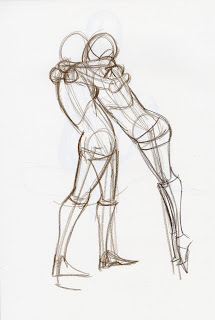
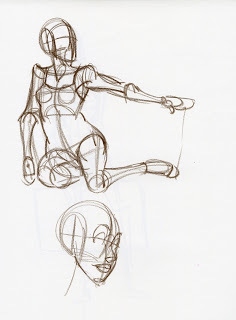
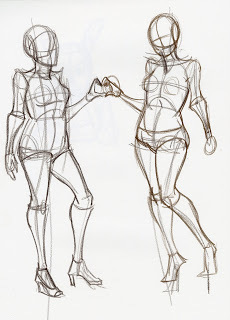
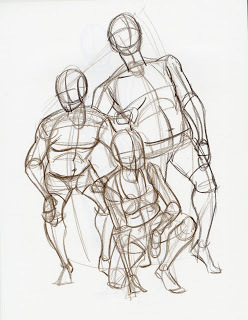 Daily Figure Studies, 5 Min Per Figure, from SenshiStock
Daily Figure Studies, 5 Min Per Figure, from SenshiStock
Why Warm Up?
Limbers up your hands- muscles and tendons- resulting in better drawingLess likely to injure your handsHelps build your mental library of objects, poses- will result in better drawing from imaginationImproves your knowledge of structure, human bodyWill enable faster drawing
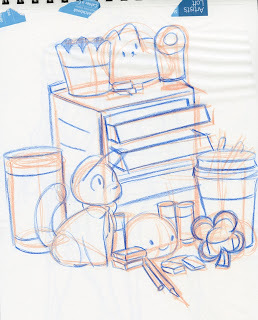 Still Life, Set up at Home, 20 Minutes
Still Life, Set up at Home, 20 Minutes
Great Daily Warmup Exercises:
2 Minute Pose Sketches x 10
5-10 Minute Referenced Figure Sketches x 2
Draw an animal from reference- same animal, 3 different references
Draw 1 randomly generated character from this character generator
Pick a corner of the room you're in and sketch it for 10 minutes
Pick a household object and sketch at least three different views of the object
Set up a small still life of interesting objects and draw it for 30 minutes
You can either use some of the sites listed below, or family members can take turns posing!
Great Tools for Warming Up:
Note: Not all resources linked here are all ages appropriate. * will denote General Audience
Inspiration and Reference:
Pose Reference:
*Senshistock Pose Timer
Proko
Humanae
Croquis Cafe
Line of Action Practice Tool
Quick Poses Reference tool
New Masters Academy, lessons and reference
Bodies in Motion
Quickposes
New Masters Academy
Drawing Prompts:
*Quick Character Generator
*Character Generator
Character Designs reference generator
Sketch Daily Reference Generator
Character Designs:




 Daily Figure Studies, 5 Min Per Figure, from SenshiStock
Daily Figure Studies, 5 Min Per Figure, from SenshiStockWhy Warm Up?
Limbers up your hands- muscles and tendons- resulting in better drawingLess likely to injure your handsHelps build your mental library of objects, poses- will result in better drawing from imaginationImproves your knowledge of structure, human bodyWill enable faster drawing
 Still Life, Set up at Home, 20 Minutes
Still Life, Set up at Home, 20 MinutesGreat Daily Warmup Exercises:
2 Minute Pose Sketches x 10
5-10 Minute Referenced Figure Sketches x 2
Draw an animal from reference- same animal, 3 different references
Draw 1 randomly generated character from this character generator
Pick a corner of the room you're in and sketch it for 10 minutes
Pick a household object and sketch at least three different views of the object
Set up a small still life of interesting objects and draw it for 30 minutes
You can either use some of the sites listed below, or family members can take turns posing!
Great Tools for Warming Up:
Note: Not all resources linked here are all ages appropriate. * will denote General Audience
Inspiration and Reference:
Pose Reference:
*Senshistock Pose Timer
Proko
Humanae
Croquis Cafe
Line of Action Practice Tool
Quick Poses Reference tool
New Masters Academy, lessons and reference
Bodies in Motion
Quickposes
New Masters Academy
Drawing Prompts:
*Quick Character Generator
*Character Generator
Character Designs reference generator
Sketch Daily Reference Generator
Character Designs:

Published on March 23, 2020 13:00
February 17, 2020
Comic Artist Starter Kit Gift Guide
Art supplies are great but the MOST important thing you can give is support. This is demonstrated in interest, involvement, and encouragement.
Some artists choose to work digitally, some choose to work with traditional supplies, so select materials that will work best for your artist! If you'd like to familiarize yourself with comic materials more before purchasing, I recommend you check out Getting to Know: Traditional Comic Materials.
Great Basics for Teen and Adult Beginners
Options were selected based on affordability and accessibility. This is designed to point you in the right direction, but you don't need to buy everything on the list! Products chosen were selected based on being applicable to a wide age range but still useful for those new to making comics.

Papers:
9"x12" Strathmore 300 Series Smooth Bristol
Canson Mixed Media Paper
Canson XL Watercolor Paper
Cardstock
Pencils:
Pilot Color Eno colored leads
Pilot G2 Pencils
Col-Erase Pencils
Pens:
Sakura Pigma FB, MB, BB
Pentel Pigment Brushpen
Pentel Pocketbrush
Kuretake Fudegokochi
Sakura Microns
Erasers:
Pentel Hi Polymer Eraser
Pentel Clic Erase
Rulers:
18" Clear Acrylic Ruler (ideally with an inking edge- a strip of metal inserted into one side)
T-Square
Accessories:
Drafting Brush
Presentation Portfolio
Storage Portfolio
Page Protectors and Binder
Drawing Boards and Work Surfaces:
Futura Drafting Table (I own this one!)
Simple Portable Drawing Board (I own a couple of these, they're lightweight but very sturdy)
Drafting Board for Construction and Engineering
Large Drawing Board Easel
Wood Drawer Drawing Board
2 Drawer Walnut Adjustable Storage Box with Folding Easel

Supply Storage:
Desktop storage:
96 Hole Pencil and Brush Holder- Desk Rack
Desktop Storage Tray
Spin-o-Tray, Rotating Desktop Organizer
Totes and Bins:
Craft Storage Box with Lift Out Tray
Artbin Super Satchel with Removable Dividers
12" Plastic Art Supply Tool Box
Pencil Cases:
Medium Capacity Pencil Case
Linen Pencil Case
Large Capacity Organizer: 202 Pencil Case with Zippered Closure
High Capacity Pencil Pouch
Big Capacity Pencil Case
Software:
Clip Studio Paint
Medibang Paint (free)
Affinity Photo
Procreate (Mac OS only)
Hardware:
Tablets:
XP-Pen Graphics Tablet, 10X6.5"
XP-Pen Artist 11.6" FHD Drawing Moniter
Huion Inspiroy Q11k V2 Wireless Drawing Tablet
Huion KAMVAS Pro 13 GT-133 Drawing Monitor
Apple iPad 10.2"- 32GB
Apple Pencil
For Your Phone:
Bamboo Tip Stylus
Other Giftguides to Inspire:
2019 Video Giftguides:
Walmart
Michaels
Dollar Tree
2018 Holiday Watercolor Gift Guide
2018 Comic Artist Gift Guide
Intermediate Alcohol Marker Artist Gift Guide
Watercolor Gift Guide- Beginner
Gift Guide for Intermediate and Beginner Artists
Holiday Gift Guide: Alcohol Markers for the Aspiring Artist
Watercolor Gift Guide for Young Artists- Ages 9-13
Holiday Gift Guide: Buying for Adult Artists
Budget Watercolor Recommendations
Gift Guide: Amateur (Student) Artist
Recommended Products of 2015

Some artists choose to work digitally, some choose to work with traditional supplies, so select materials that will work best for your artist! If you'd like to familiarize yourself with comic materials more before purchasing, I recommend you check out Getting to Know: Traditional Comic Materials.
Great Basics for Teen and Adult Beginners
Options were selected based on affordability and accessibility. This is designed to point you in the right direction, but you don't need to buy everything on the list! Products chosen were selected based on being applicable to a wide age range but still useful for those new to making comics.

Papers:
9"x12" Strathmore 300 Series Smooth Bristol
Canson Mixed Media Paper
Canson XL Watercolor Paper
Cardstock
Pencils:
Pilot Color Eno colored leads
Pilot G2 Pencils
Col-Erase Pencils
Pens:
Sakura Pigma FB, MB, BB
Pentel Pigment Brushpen
Pentel Pocketbrush
Kuretake Fudegokochi
Sakura Microns
Erasers:
Pentel Hi Polymer Eraser
Pentel Clic Erase
Rulers:
18" Clear Acrylic Ruler (ideally with an inking edge- a strip of metal inserted into one side)
T-Square
Accessories:
Drafting Brush
Presentation Portfolio
Storage Portfolio
Page Protectors and Binder
Drawing Boards and Work Surfaces:
Futura Drafting Table (I own this one!)
Simple Portable Drawing Board (I own a couple of these, they're lightweight but very sturdy)
Drafting Board for Construction and Engineering
Large Drawing Board Easel
Wood Drawer Drawing Board
2 Drawer Walnut Adjustable Storage Box with Folding Easel

Supply Storage:
Desktop storage:
96 Hole Pencil and Brush Holder- Desk Rack
Desktop Storage Tray
Spin-o-Tray, Rotating Desktop Organizer
Totes and Bins:
Craft Storage Box with Lift Out Tray
Artbin Super Satchel with Removable Dividers
12" Plastic Art Supply Tool Box
Pencil Cases:
Medium Capacity Pencil Case
Linen Pencil Case
Large Capacity Organizer: 202 Pencil Case with Zippered Closure
High Capacity Pencil Pouch
Big Capacity Pencil Case
Software:
Clip Studio Paint
Medibang Paint (free)
Affinity Photo
Procreate (Mac OS only)
Hardware:
Tablets:
XP-Pen Graphics Tablet, 10X6.5"
XP-Pen Artist 11.6" FHD Drawing Moniter
Huion Inspiroy Q11k V2 Wireless Drawing Tablet
Huion KAMVAS Pro 13 GT-133 Drawing Monitor
Apple iPad 10.2"- 32GB
Apple Pencil
For Your Phone:
Bamboo Tip Stylus
Other Giftguides to Inspire:
2019 Video Giftguides:
Walmart
Michaels
Dollar Tree
2018 Holiday Watercolor Gift Guide
2018 Comic Artist Gift Guide
Intermediate Alcohol Marker Artist Gift Guide
Watercolor Gift Guide- Beginner
Gift Guide for Intermediate and Beginner Artists
Holiday Gift Guide: Alcohol Markers for the Aspiring Artist
Watercolor Gift Guide for Young Artists- Ages 9-13
Holiday Gift Guide: Buying for Adult Artists
Budget Watercolor Recommendations
Gift Guide: Amateur (Student) Artist
Recommended Products of 2015

Published on February 17, 2020 13:00
February 14, 2020
Valentine's Day 2020
Every year, my mom has sent or given me a Valentine. Sometimes at my seat at the table, sometimes wrapped in excelsior. Some years it was expansive- candy and stuffed animals, some years it was small- but every year at Valentine's, I knew I could look forward to a sweet reminder from my mother that I was loved and valued as a person.
This continued well after I started having boyfriends- I knew no matter what was going on (and one year, I got dumped on Valentine's Day), my mom had my back on Valentine's. It's a tradition that continued into Undergraduate, where my Valentine would be waiting for me at the house, and into Graduate school, where my Valentine was mailed to me, and has even followed me here to Nashville. As I got older and had some income, I was able to return the sentiment and send her Valentines (usually flowers) in return.
It's not really about receiving a gift. It's about exchanging a sentiment between two women who sometimes struggle with vulnerability. It's about taking the time to express love and affection.
Valentine's Day isn't really a romantic holiday for me. I don't like fighting the crowds to eat out, and while I like chocolates and flowers, I'm happy to wait a couple days and get them half off. I treat Valentine's Day as a wonderful excuse to tell the people (and animals!) in my life that I love and appreciate them. While I ALWAYS love them, sometimes I need an external reminder to be grateful, appreciative, and demonstrative in my esteem. So many people don't hear "I love you" or "I value our friendship" or "you make me smile" enough and it can be easy to assume we have no positive impact in the lives of others without this external validation.
So I hope you guys will take some time out today to tell others in your life just how much they mean to you!

Valentine's Day is also a great day to remind yourself of all the reasons why you love YOU.
You guys are probably wondering what this has to do with art, or watercolor, or comics. I see so many artists online who hate themselves- it's pretty obvious. Attacking other artists who are more popular than they are over micro transgressions, constantly dogging their own work, forever putting themselves down. I think a lot of artists struggle with feeling like they DESERVE to love themselves.
I've been there, and it's something I struggle with daily- which is why it's so important to try and love yourself as you would a friend. Sometimes you have to separate and talk to yourself the way you would a friend you value and trust- because you work hard, you put yourself out there, and regardless of whether other people see your value, YOU HAVE VALUE.
It was the culmination of failing to meet my goals (which, admittedly, were often set outside the realm of my control), difficulty in maintaining boundaries (after years of unemployment, I struggle to say no to 'feature creep' from employers), and feeling isolated from the comic community in Nashville. A heady dose of 'unemployed and can't find work' added to that bad brew- I created the echo chamber that was killing me. I really didn't think someone who was so unemployable, someone who could draw and share work every day, but still couldn't find work- deserved self love, and I reserved that 'privilege' for when I felt like I was actually worth something.
Beating a dead horse doesn't bring it back to life. It doesn't make it walk, and a dead horse can't carry any burdens. I was emotionally abusing myself to suicide.
I was so lucky to befriend Kabocha at this time. Our friendship inspired me to take the first steps in turning my life and viewpoint around.
Depression, anxiety, mental health or disability drastically color how we view ourselves, our interactions, the world around us. I have ADHD, depression, and anxiety, so you can imagine the weird tints my feelings color the world and my experiences. For years, I really struggled with confidence issues and asserting myself- I would let opportunities pass me by without even trying, or self sabotage my efforts because in the back of my mind, I was SURE I'd let them down. Working on loving myself has helped me ease the symptoms of anxiety and depression by inspiring self care before things spiral out of control- taking breaks, taking walks, eating regular meals, stretching, getting some outside perspective, and loving myself has allowed me to embrace my ADHD and try to work with it, rather than fight it. Eating a meal before the anxiety got too bad and made me sick. Going to bed before the 'witching hour' arrived and depression clawed its way in. Accepting that as someone with ADHD, I am creative, engaging, empathetic but also that my feelings are often more intense than a situation merits, and the feeling of never quite measuring up and being good enough might be all in my head.
The struggle out wasn't and still isn't easy. It's been almost four years since I couldn't even look at myself in a mirror, even in passing. Now I can smile at myself, compliment myself, tell Becca she put in a good day's work. But it's been four years of actively trying to rewire my mind, how I think about myself, and how I talk about myself. Shutting down the negative self-talk just as it starts, putting on music or reading a book to drown it out and distract me just enough to focus.
Here's your permission. Please start today. Try to see yourself as a friend, an ally in your struggles and a companion in your life's journey. Try to see your body as a loyal and hardworking vehicle, always trying to serve the needs of the mind, even if sometimes it cannot succeed due to the limitations of health and humanity. Take the steps necessary for self care- turning off social media notifications, finding or creating a group of supportive friends you can turn to, eating regular meals and drinking plenty of water, setting and keeping a reasonable bedtime. While these won't cure anxiety, depression, or mental illness, they definitely make it a lot easier to tackle the symptoms.
This continued well after I started having boyfriends- I knew no matter what was going on (and one year, I got dumped on Valentine's Day), my mom had my back on Valentine's. It's a tradition that continued into Undergraduate, where my Valentine would be waiting for me at the house, and into Graduate school, where my Valentine was mailed to me, and has even followed me here to Nashville. As I got older and had some income, I was able to return the sentiment and send her Valentines (usually flowers) in return.
It's not really about receiving a gift. It's about exchanging a sentiment between two women who sometimes struggle with vulnerability. It's about taking the time to express love and affection.
Valentine's Day isn't really a romantic holiday for me. I don't like fighting the crowds to eat out, and while I like chocolates and flowers, I'm happy to wait a couple days and get them half off. I treat Valentine's Day as a wonderful excuse to tell the people (and animals!) in my life that I love and appreciate them. While I ALWAYS love them, sometimes I need an external reminder to be grateful, appreciative, and demonstrative in my esteem. So many people don't hear "I love you" or "I value our friendship" or "you make me smile" enough and it can be easy to assume we have no positive impact in the lives of others without this external validation.
So I hope you guys will take some time out today to tell others in your life just how much they mean to you!

Valentine's Day is also a great day to remind yourself of all the reasons why you love YOU.
You guys are probably wondering what this has to do with art, or watercolor, or comics. I see so many artists online who hate themselves- it's pretty obvious. Attacking other artists who are more popular than they are over micro transgressions, constantly dogging their own work, forever putting themselves down. I think a lot of artists struggle with feeling like they DESERVE to love themselves.
I've been there, and it's something I struggle with daily- which is why it's so important to try and love yourself as you would a friend. Sometimes you have to separate and talk to yourself the way you would a friend you value and trust- because you work hard, you put yourself out there, and regardless of whether other people see your value, YOU HAVE VALUE.
It was the culmination of failing to meet my goals (which, admittedly, were often set outside the realm of my control), difficulty in maintaining boundaries (after years of unemployment, I struggle to say no to 'feature creep' from employers), and feeling isolated from the comic community in Nashville. A heady dose of 'unemployed and can't find work' added to that bad brew- I created the echo chamber that was killing me. I really didn't think someone who was so unemployable, someone who could draw and share work every day, but still couldn't find work- deserved self love, and I reserved that 'privilege' for when I felt like I was actually worth something.
Beating a dead horse doesn't bring it back to life. It doesn't make it walk, and a dead horse can't carry any burdens. I was emotionally abusing myself to suicide.
I was so lucky to befriend Kabocha at this time. Our friendship inspired me to take the first steps in turning my life and viewpoint around.
Depression, anxiety, mental health or disability drastically color how we view ourselves, our interactions, the world around us. I have ADHD, depression, and anxiety, so you can imagine the weird tints my feelings color the world and my experiences. For years, I really struggled with confidence issues and asserting myself- I would let opportunities pass me by without even trying, or self sabotage my efforts because in the back of my mind, I was SURE I'd let them down. Working on loving myself has helped me ease the symptoms of anxiety and depression by inspiring self care before things spiral out of control- taking breaks, taking walks, eating regular meals, stretching, getting some outside perspective, and loving myself has allowed me to embrace my ADHD and try to work with it, rather than fight it. Eating a meal before the anxiety got too bad and made me sick. Going to bed before the 'witching hour' arrived and depression clawed its way in. Accepting that as someone with ADHD, I am creative, engaging, empathetic but also that my feelings are often more intense than a situation merits, and the feeling of never quite measuring up and being good enough might be all in my head.
The struggle out wasn't and still isn't easy. It's been almost four years since I couldn't even look at myself in a mirror, even in passing. Now I can smile at myself, compliment myself, tell Becca she put in a good day's work. But it's been four years of actively trying to rewire my mind, how I think about myself, and how I talk about myself. Shutting down the negative self-talk just as it starts, putting on music or reading a book to drown it out and distract me just enough to focus.
Here's your permission. Please start today. Try to see yourself as a friend, an ally in your struggles and a companion in your life's journey. Try to see your body as a loyal and hardworking vehicle, always trying to serve the needs of the mind, even if sometimes it cannot succeed due to the limitations of health and humanity. Take the steps necessary for self care- turning off social media notifications, finding or creating a group of supportive friends you can turn to, eating regular meals and drinking plenty of water, setting and keeping a reasonable bedtime. While these won't cure anxiety, depression, or mental illness, they definitely make it a lot easier to tackle the symptoms.

Published on February 14, 2020 13:00
February 11, 2020
Third Kara-versary
Today marks the third anniversary of launching 7" Kara as a webcomic, and it's been a weird ride. My nearly 10 years of work on 7" Kara has seen a lot of changes- graduating from SCAD, moving from Savannah to Nashville, working closely with other artists to working in near isolation, the formation of Ink Drop Cafe, the dissolution of Ink Drop Cafe, dozens of conventions, self-publishing Volume 1, researching comics and watercolor, teaching comics- I've grown so much while working on Kara.

The past three years, from when I first launched 7" Kara on February 11th, 2017, have not been nearly as turbulent as the whole, but it's been fruitful for development and growth. Dozens of conventions, representing my own book, joining SCBWI, regular teaching gigs, participating and moderating Ink Drop Cafe, tabling at SPX with several perfect bound books- I'm in a totally different place from when I started painting the first Kara pages.
While Kara is not my first comic by a long shot, it's the first longform comic I was willing to share not only with friends, but with the internet as a whole, and with readers via the perfect bound Volume 1. It took a lot of courage to begin uploading comic pages three years ago- the audience for web comics is pretty different from the audience for print comics, and I knew my preferred demographic isn't really using the internet yet. But I also knew sharing Kara as a webcomic would not only open me up to critique and criticism, but to potential friendships, and would give me a chance to prove myself to online peers.
The worst response I've gotten is from people who judge my current artistic ability based on what they see in Chapter 1- comic pages painted 8 years ago! Watching my art develop as I work on 7" Kara has been really exciting for me- I've always loved comics that evolved with the artist's ability, rather than sticking to an outdated 'style'. I'm proud of how far I've come in terms of ability and comfort with the medium and the artform, and I love using the contrast between Chapter 1 and Chapter 8 to inspire other artists to begin their own projects.

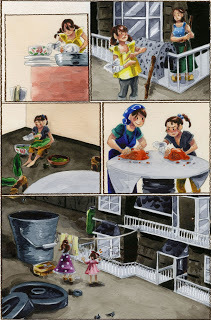 Early Page from Chapter 1, Early page from Chapter 8
Early Page from Chapter 1, Early page from Chapter 8
While working on Kara, I researched and learned so much about watercolor. Beginning the Watercolor Basics series here on the blog helped fuel that passion, and as time progressed, I learned what papers, paints, and brushes worked best for Kara comic pages, and what I preferred to use for standalone illustrations.
When I first started with Kara, I used Cotman Student Grade pans on Canson's cheapest 90lb watercolor paper, with cheap synthetic brushes- the pages are rippled, the colors chalky, the mixes muddy. I quickly upgraded my paper in Chapter 2- I've reviewed a lot of different papers over the years, and have tried even more, but I lucked out when I selected Canson Montval for comic pages, as it's still my preference. And as time passed, I slowly switched out Cotman half pans for Winsor & Newton professional half pans, and then later began experimenting with other professional brands. My watercolor brush selection grew as time passed as well, and I began to prefer natural hair brushes over synthetics.
I struggled to learn how to paint darker skintones, how to paint grass, how to draw animals and not every comic page or panel was a success. Often I spent time doing watercolor studies- practicing realistic watercolors, painting different scenerios, learning something new every time I tried to flex my wings. But without struggle we wouldn't have success, and Naomi has become one of my favorite characters to paint, and steals the stage in the Volume 2 bonus chapter, Naomi's Big Day. And anyone who follows my Instagram knows I love painting grass!
2018 and 2019 were years that marked a desire to find watercolors that performed better than the Winsor & Newton watercolors I was using, and more economical. I became friends with Kabocha, a fellow watercolor enthusiast, and we exchanged notes and paint samples. I shared many of my reviews on Youtube, hoping to help other comic artists interested in watercolor.
Working on 7" Kara has inspired so many aspects of my life, from teaching others how to create their own comics to studying watercolor. I'm excited to see where my art will go, and where inspiration will strike, as I work on the next two volumes.
VOLUME 1:
Chapter 1 Pages: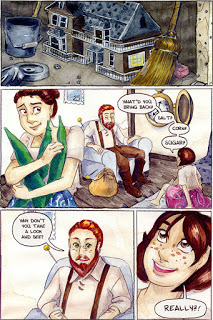
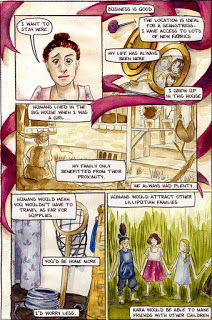 Painted 2011/2012- Cotman watercolors, Canson Beginner Watercolor Paper
Painted 2011/2012- Cotman watercolors, Canson Beginner Watercolor Paper
Chapter 2 Pages:
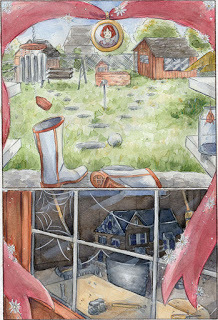
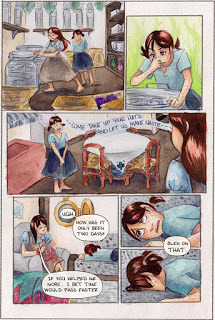 Painted 2012- Cotman and Winsor & Newton watercolors, Canson Montval Watercolor Paper
Painted 2012- Cotman and Winsor & Newton watercolors, Canson Montval Watercolor Paper
Chapter 3 Pages:
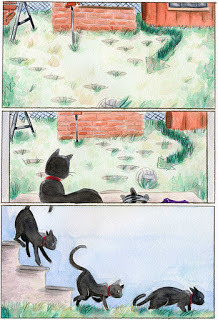
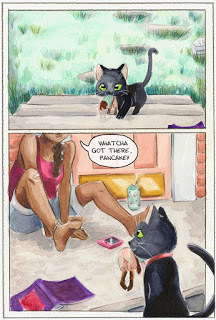 Painted 2013- Cotman and Winsor & Newton watercolors, Canson Montval Watercolor Paper
Painted 2013- Cotman and Winsor & Newton watercolors, Canson Montval Watercolor Paper
Chapter 4 Pages:
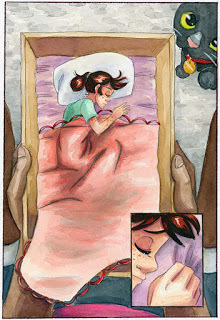
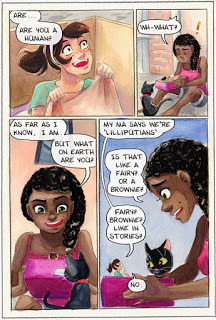 Painted 2014- Winsor and Newton watercolors, Holbein Irodori watercolors, Canson Montval Watercolor Paper
Painted 2014- Winsor and Newton watercolors, Holbein Irodori watercolors, Canson Montval Watercolor Paper
VOLUME 2:
Chapter 5 Pages:
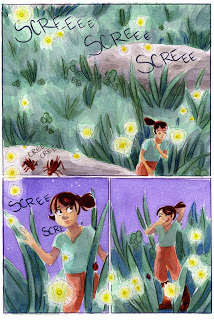
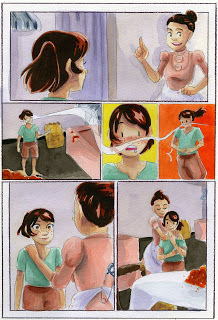 Painted 2014/2015- Winsor and Newton watercolors, Holbein Irodori watercolors, Canson Montval Watercolor Paper
Painted 2014/2015- Winsor and Newton watercolors, Holbein Irodori watercolors, Canson Montval Watercolor Paper
Chapter 6:
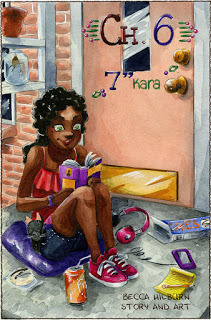
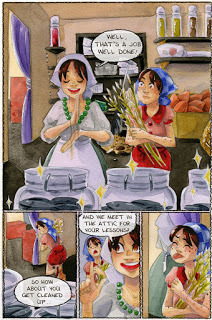 Painted 2016- Daniel Smith watercolors, Mijello watercolors, Soho watercolors, Winsor & Newton watercolors, Canson Montval watercolor paper
Painted 2016- Daniel Smith watercolors, Mijello watercolors, Soho watercolors, Winsor & Newton watercolors, Canson Montval watercolor paper
Chapter 7 Pages:
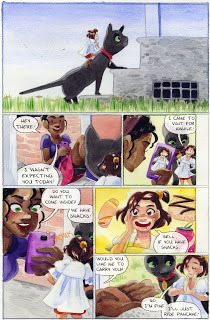
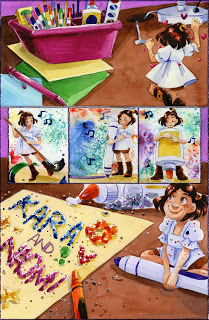 Painted 2017/2018- Daniel Smith watercolors, Mijello watercolors, Soho watercolors, Winsor & Newton watercolors, Canson Montval watercolor paper
Painted 2017/2018- Daniel Smith watercolors, Mijello watercolors, Soho watercolors, Winsor & Newton watercolors, Canson Montval watercolor paper
Chapter 8 Pages:
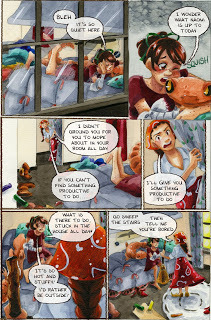
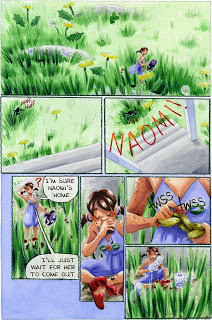 Painted 2018/ 2019- Daniel Smith watercolors, Holbein watercolors, Mijello Watercolors, Sennelier watercolors, Soho watercolors, Winsor & Newton watercolors, Canson Montval watercolor paper
Painted 2018/ 2019- Daniel Smith watercolors, Holbein watercolors, Mijello Watercolors, Sennelier watercolors, Soho watercolors, Winsor & Newton watercolors, Canson Montval watercolor paper
Those of you who keep up with the webcomic have probably noticed that after Chapter 6, 7" Kara went on hiatus. I have three additional chapters painted and lettered- ready to go, but I'm holding onto those as a special incentive to support the Volume 2 Kickstarter. If you'd like to keep on top of Kickstarter news, you can sign up for the mailing list- I have a lot of newsletter exclusive stuff planned! And hopefully you'll consider supporting Volume 2 after the Kickstarter launches- your support means the world to me, and inspires me to continue painting.


The past three years, from when I first launched 7" Kara on February 11th, 2017, have not been nearly as turbulent as the whole, but it's been fruitful for development and growth. Dozens of conventions, representing my own book, joining SCBWI, regular teaching gigs, participating and moderating Ink Drop Cafe, tabling at SPX with several perfect bound books- I'm in a totally different place from when I started painting the first Kara pages.
While Kara is not my first comic by a long shot, it's the first longform comic I was willing to share not only with friends, but with the internet as a whole, and with readers via the perfect bound Volume 1. It took a lot of courage to begin uploading comic pages three years ago- the audience for web comics is pretty different from the audience for print comics, and I knew my preferred demographic isn't really using the internet yet. But I also knew sharing Kara as a webcomic would not only open me up to critique and criticism, but to potential friendships, and would give me a chance to prove myself to online peers.
The worst response I've gotten is from people who judge my current artistic ability based on what they see in Chapter 1- comic pages painted 8 years ago! Watching my art develop as I work on 7" Kara has been really exciting for me- I've always loved comics that evolved with the artist's ability, rather than sticking to an outdated 'style'. I'm proud of how far I've come in terms of ability and comfort with the medium and the artform, and I love using the contrast between Chapter 1 and Chapter 8 to inspire other artists to begin their own projects.

 Early Page from Chapter 1, Early page from Chapter 8
Early Page from Chapter 1, Early page from Chapter 8While working on Kara, I researched and learned so much about watercolor. Beginning the Watercolor Basics series here on the blog helped fuel that passion, and as time progressed, I learned what papers, paints, and brushes worked best for Kara comic pages, and what I preferred to use for standalone illustrations.
When I first started with Kara, I used Cotman Student Grade pans on Canson's cheapest 90lb watercolor paper, with cheap synthetic brushes- the pages are rippled, the colors chalky, the mixes muddy. I quickly upgraded my paper in Chapter 2- I've reviewed a lot of different papers over the years, and have tried even more, but I lucked out when I selected Canson Montval for comic pages, as it's still my preference. And as time passed, I slowly switched out Cotman half pans for Winsor & Newton professional half pans, and then later began experimenting with other professional brands. My watercolor brush selection grew as time passed as well, and I began to prefer natural hair brushes over synthetics.
I struggled to learn how to paint darker skintones, how to paint grass, how to draw animals and not every comic page or panel was a success. Often I spent time doing watercolor studies- practicing realistic watercolors, painting different scenerios, learning something new every time I tried to flex my wings. But without struggle we wouldn't have success, and Naomi has become one of my favorite characters to paint, and steals the stage in the Volume 2 bonus chapter, Naomi's Big Day. And anyone who follows my Instagram knows I love painting grass!
2018 and 2019 were years that marked a desire to find watercolors that performed better than the Winsor & Newton watercolors I was using, and more economical. I became friends with Kabocha, a fellow watercolor enthusiast, and we exchanged notes and paint samples. I shared many of my reviews on Youtube, hoping to help other comic artists interested in watercolor.
Working on 7" Kara has inspired so many aspects of my life, from teaching others how to create their own comics to studying watercolor. I'm excited to see where my art will go, and where inspiration will strike, as I work on the next two volumes.
VOLUME 1:
Chapter 1 Pages:

 Painted 2011/2012- Cotman watercolors, Canson Beginner Watercolor Paper
Painted 2011/2012- Cotman watercolors, Canson Beginner Watercolor PaperChapter 2 Pages:

 Painted 2012- Cotman and Winsor & Newton watercolors, Canson Montval Watercolor Paper
Painted 2012- Cotman and Winsor & Newton watercolors, Canson Montval Watercolor PaperChapter 3 Pages:

 Painted 2013- Cotman and Winsor & Newton watercolors, Canson Montval Watercolor Paper
Painted 2013- Cotman and Winsor & Newton watercolors, Canson Montval Watercolor PaperChapter 4 Pages:

 Painted 2014- Winsor and Newton watercolors, Holbein Irodori watercolors, Canson Montval Watercolor Paper
Painted 2014- Winsor and Newton watercolors, Holbein Irodori watercolors, Canson Montval Watercolor PaperVOLUME 2:
Chapter 5 Pages:

 Painted 2014/2015- Winsor and Newton watercolors, Holbein Irodori watercolors, Canson Montval Watercolor Paper
Painted 2014/2015- Winsor and Newton watercolors, Holbein Irodori watercolors, Canson Montval Watercolor PaperChapter 6:

 Painted 2016- Daniel Smith watercolors, Mijello watercolors, Soho watercolors, Winsor & Newton watercolors, Canson Montval watercolor paper
Painted 2016- Daniel Smith watercolors, Mijello watercolors, Soho watercolors, Winsor & Newton watercolors, Canson Montval watercolor paperChapter 7 Pages:

 Painted 2017/2018- Daniel Smith watercolors, Mijello watercolors, Soho watercolors, Winsor & Newton watercolors, Canson Montval watercolor paper
Painted 2017/2018- Daniel Smith watercolors, Mijello watercolors, Soho watercolors, Winsor & Newton watercolors, Canson Montval watercolor paperChapter 8 Pages:

 Painted 2018/ 2019- Daniel Smith watercolors, Holbein watercolors, Mijello Watercolors, Sennelier watercolors, Soho watercolors, Winsor & Newton watercolors, Canson Montval watercolor paper
Painted 2018/ 2019- Daniel Smith watercolors, Holbein watercolors, Mijello Watercolors, Sennelier watercolors, Soho watercolors, Winsor & Newton watercolors, Canson Montval watercolor paperThose of you who keep up with the webcomic have probably noticed that after Chapter 6, 7" Kara went on hiatus. I have three additional chapters painted and lettered- ready to go, but I'm holding onto those as a special incentive to support the Volume 2 Kickstarter. If you'd like to keep on top of Kickstarter news, you can sign up for the mailing list- I have a lot of newsletter exclusive stuff planned! And hopefully you'll consider supporting Volume 2 after the Kickstarter launches- your support means the world to me, and inspires me to continue painting.

Published on February 11, 2020 13:00



